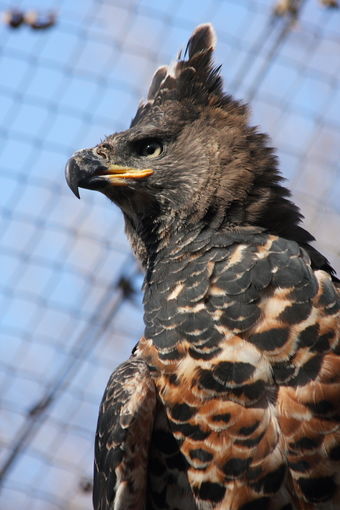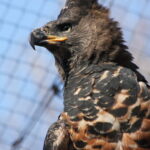Crowned eagles (Stephanoaetus coronatus) are large, powerful birds of prey found in sub-Saharan Africa. While these majestic birds possess many impressive physical features, the question of whether they have tongues is an intriguing one. Let’s dive into the details and explore the answer.
The Anatomy of Crowned Eagles
Crowned eagles are known for their striking appearance, with a dark to rufous-tinged brown crown and a prominent, black-tipped double crest. Their upperparts are a blackish brown-grey color, while their belly and breast are white overlaid densely with blackish bars and blotches.
Do Crowned Eagles Have Tongues?
Yes, crowned eagles do have tongues. Like other birds, crowned eagles possess a tongue that is located in the floor of their mouth. The tongue of a crowned eagle is relatively small and thin, and it plays a crucial role in their feeding and swallowing behaviors.
The Function of the Crowned Eagle’s Tongue
The tongue of a crowned eagle serves several important functions:
-
Manipulation of Food: The tongue helps the eagle manipulate and position food in its beak, allowing it to tear and swallow its prey more efficiently.
-
Swallowing: The tongue assists in the swallowing process by helping to push food down the eagle’s throat and into its esophagus.
-
Taste and Sensory Perception: While the sense of taste in birds is generally less developed than in mammals, the tongue of a crowned eagle does contain taste buds that allow it to perceive certain flavors and textures of its food.
-
Grooming: Crowned eagles use their tongues to groom and clean their feathers, helping to maintain their overall health and appearance.
Comparison to Other Raptor Tongues
The tongue of a crowned eagle is similar in structure and function to the tongues of other raptors, such as hawks, falcons, and eagles. However, the specific size, shape, and sensitivity of the tongue can vary between different species of birds of prey, depending on their feeding habits and prey preferences.
Crowned Eagles and Their Hunting Behavior
Crowned eagles are carnivores, and their diet consists mostly of mammals, including small ungulates, rock hyrax, and small primates such as monkeys. They are known for their impressive hunting abilities and their powerful talons, which they use to capture and kill their prey.
Hunting Techniques
Crowned eagles employ a variety of hunting techniques, including:
-
Perch Hunting: They often perch in tall trees or on high vantage points, scanning the surrounding area for potential prey.
-
Soaring and Gliding: Crowned eagles are skilled at soaring and gliding, using their keen eyesight to spot prey from a distance.
-
Aerial Attacks: When they spot a suitable target, crowned eagles will swoop down and attack their prey with their powerful talons.
The Role of the Tongue in Hunting
While the tongue of a crowned eagle is not directly involved in the actual hunting process, it does play a crucial role in the eagle’s ability to feed on its prey. The tongue helps the eagle manipulate and swallow the food, ensuring that it can efficiently consume its catch and obtain the necessary nutrients to sustain its energy-intensive lifestyle.
Conservation Efforts for Crowned Eagles
Unfortunately, crowned eagles are listed as Near Threatened on the IUCN Red List due to various threats, including habitat loss and fragmentation, collisions with human structures, electrocution from power lines, and persecution for arrow fletchings, food, witchcraft, and ornaments.
Threats to Crowned Eagles
-
Habitat Loss and Fragmentation: The conversion of forests and savannas to agricultural land and urban areas has led to a decline in the available habitat for crowned eagles.
-
Human-Wildlife Conflict: Crowned eagles are sometimes persecuted by humans who view them as a threat to livestock or perceive them as a nuisance.
-
Electrocution and Collisions: Crowned eagles are at risk of being electrocuted by power lines or colliding with other human-made structures, such as wind turbines and communication towers.
Conservation Efforts
To help protect crowned eagles, conservation efforts are focused on:
-
Habitat Protection: Establishing and expanding protected areas to preserve the remaining forests and savannas where crowned eagles live.
-
Mitigation of Threats: Upgrading electrical networks to reduce the risk of electrocution and implementing measures to prevent collisions with human-made structures.
-
Monitoring and Research: Conducting ongoing monitoring and research to better understand the population trends and ecology of crowned eagles, which can inform conservation strategies.
-
Community Engagement: Educating local communities about the importance of crowned eagles and working with them to reduce persecution and promote coexistence.
By addressing the key threats and implementing effective conservation measures, we can help ensure the long-term survival of these magnificent birds of prey.
Conclusion
In conclusion, crowned eagles do possess tongues, which play a crucial role in their feeding and grooming behaviors. While their tongues may not be as prominent as some other physical features, they are an essential part of the crowned eagle’s anatomy and contribute to its overall success as a predator. By understanding the biology and conservation needs of these impressive birds, we can work to protect them and ensure their continued presence in the ecosystems of sub-Saharan Africa.
References:
– https://animals.sandiegozoo.org/animals/crowned-eagle
– https://factanimal.com/crowned-eagle/
– https://animalia.bio/crowned-eagle


